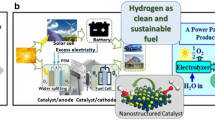Catalytic CO oxidation on platinum group metals can exhibit nonlinear behaviors like catastrophe, bistability, and hysteresis, which are indicative of self-organizing processes occurring in the course of the oxidation reaction. As a result, the system demonstrates a multi-branch nonlinear input/output relationship for which the output value depends not only on the instantaneous input values, but also on the history of operations. Traditional linear control approaches may cause unstable operation in the CO oxidation reaction. In this paper, a nonlinear control strategy is proposed to solve the control problem. The control strategy incorporates a PI controller and a switching control strategy by which the control system can maintain a high regulating performance while preventing unstable operation. It may be applied to control operations in industrial processes of catalytic CO oxidation.






Similar content being viewed by others
References
Y. Suchorski, J. Beben, E. W. James, J. W. Evans, and IL Imbihl, “Fluctuation-induced transitions in a bistable surface reaction: catalytic CO oxidation on a Pt field emitter tip,” Phys. Rev. Lett, 82(9), 1907- 1910 (1999).
L. Dajiang and J.W. Evans, “Symmetry-breaking and percolation transitions in a surface reaction model with superlattice ordering,” Phys. Rev. Len.. 84(5), 955-958 (2000).
N. Pavlenko, J.W. Evans, L. Dajiang. and R. Imbihl, “Catalytic CO oxidation on nanoscale Pt facets: Effect of interfacet CO diffusion on bifurcation and fluctuation behavior,”Phys. Rev. E, 65, 0161211(2001).
D. Hua and Y. Ma, “Hysteresis phenomena in CO catalytic oxidation system in the presence of inhomogeneities of the catalyst surface,” Phys. Rev. E, 66, 66103 (2002).
M. Bar, C. Zulicke, M. Eiswirth, and G Ertl, “Theoretical modeling of spatiotemporal self-organization in a surface catalyzed reaction exhibiting bistable kinetics,”J. Chem. Phys., 96, 8595-8604 (1992).
M. S. Monza, A. Hammoudeh, J. Loboda-Cackovic, and J. H. Block, “The CO-oxidation on Pd-rich surfaces of PdCu (110): hysteresis in reaction rates,” J. Mot. Carat. A: Chem., 96, 271-276 (1995).
L. Dajiang and J.W. Evans, “Chemical diffusion of CO in mixed CO+O adlayers and reaction-front propagation in CO oxidation on Pd (100),” J. Chem. Phys., 125, 54709 (2006).
N. Pavlenko, J. W. Evans, D. J. Liu, and R. Imbihl, “Catalytic CO oxidation on nanoscale Pt facets: effect of interfacet CO diffusion on bifurcation and fluctuation behaviour,” Plys. Rev. E, 65, 16121 (2002).
S. Rarpitschka, S. Wehner, and J. Küppers, “Reaction hysteresis of the CO+O → CO2 reaction on palladium(111),” J. Chem. Phys., 130, 54706 (2009).
R. Imbihl, “fluctuations in catalytic surface reactions,” New J. Phys., 62, 621-627 (2003).
H. Yumino, W. Stefan, R. Jurgen, and H. R. Brand. “External noise imposed on the reaction-diffusion system CO+O2→ CO2 on Ir(111) surfaces: experiment and theory,” Phys. Rev. E, 69, 0216091 (2004).
A. Armaou and I. G Revrekidis, “Equation-free optimal switching policies for bistable reacting systems,” Int. J. Robust Nonlinear Control, 15, 713-726 (2005).
M. Pineda, R. Imbihl, and L. Schimansky-Geier, “Effects of surface size on minimalistic stochastic models for the catalytic CO oxidation,” Physics: A, 389, 1178-1188 (2010).
M.S. Branicky, “Multiple Lyapunov functions and other analysis tools for switched and hybrid systems,” IEEE Trans. Autom. Control, 43(4), 475-482 (1998).
M. Wang, J. Zhao, and M. G. Dimirovski, “Output tracking control of nonlinear switched cascade systems using a variable structure control method,” Int. J. Control, 83(2), 394-403 (2010).
H. Ye, A.N. Michael, and L. Hou, “Stability theory for hybrid dynamic systems, “IEEE Trans. Autom. Control, 43(4), 461-474 (1998).
H.Y. Li, Y.Z. Luo, and G.J. Tang, “Optimal multi-objective linearized impulsive rendezvous under uncertainty,” Acta Astronaut., 66(3), 439-445 (2010).
P. Stewart, D. Gladwin, M. Parr, and J. Stewart, “Multi-objective evolutionary—fuzzy augmented flight control for an F16 aircraft,” Proc. Inst. Mech. Eng., Part G: J. Aerospace Eng., 224(3), 293-309 (2010).
B. Niu, X. Zhao, X. Fan, and Y. Cheng, “A new control method for state-constrained nonlinear switched systems with application to chemical process,” Int. J. Control, 88(9), 1-8 (2015).
Author information
Authors and Affiliations
Corresponding author
Additional information
Translated from khimiya i Tekhnologiya Topliv i Masel, No. 5, pp. 90-95, September — October, 2019.
Rights and permissions
About this article
Cite this article
Zhang, L., Cao, R. & Sheng, L. Nonlinear Switching Control of the CO Oxidation Reaction Rate in Hydrogen Production. Chem Technol Fuels Oils 55, 652–659 (2019). https://doi.org/10.1007/s10553-019-01078-6
Published:
Issue Date:
DOI: https://doi.org/10.1007/s10553-019-01078-6




